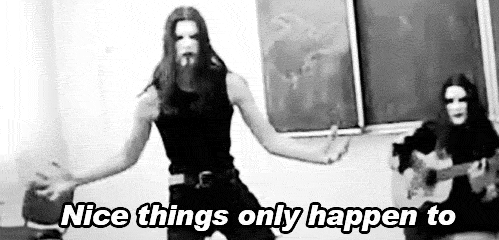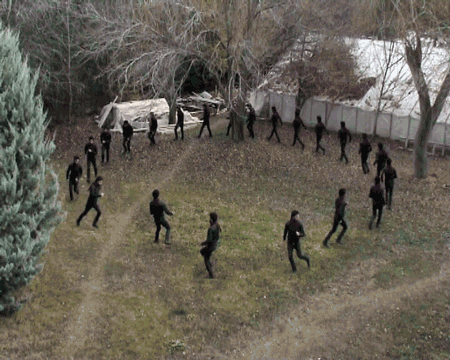Happened to look in on a blog for a course on Philosophy and Pop Culture at TRU. Saw a post that I thought was remarkable for a couple reasons.
A student had just posted some fresh reflections, though the course was over. He wrote: “I know that I no longer need to create new posts, but it seemed like this is the perfect place to post my current thoughts.”
This in itself is remarkable, though not so unusual. I suppose some would find it trite to observe this would rarely occur in an LMS, even if the student was not locked out of the course environment as a matter of university policy at course’s end. Here, even in a shared course blog on an institutional WordPress install, this student felt a stake in this space, understood that it was a place for continued reflection and growth.
The student was exploring, in part, his ongoing responses to Andrew Wildman’s graphic novel Horizon. Educational bloggers will not be so surprised to see that Wildman offered a comment on the blog in response. Again, would that happen in an LMS? If mediums communicate messages, this exchange illustrates that the student’s thoughts and words have value. The student is not merely engaging in a simulation of intellectual discourse, but taking their thoughts into the world.
I couldn’t resist Tweeting this exchange when I saw it. Which again, not so surprisingly elicited yet another comment from the most thoughtful and engaged commenter I have ever known.
These sorts of things happen all the time over on UMW Blogs, but we are still building out our infrastructure and culture of open online learning here at TRU. I hope these stories become commonplace here soon.
Another common manifestation of open learning went down in my personal network yesterday. That it happened without really seeming all that remarkable at the time is hitting me as amazing right now. (Was there something in those brownies I just ate?)
I’m doing a little bit of preparation for next Monday’s VideoCamp here at TRU. Since I am an utter neophyte at video work (thankfully we have a cohort of other facilitators lined up), the only “teaching” I might do is work through Popcorn Maker with any participants who just want a simple tool for basic augmentation and remixing of online video. I remembered that Clint Lalonde had organized workshops using Popcorn, and then remembered that I am lazy and shameless, so I fired Clint a Twitter DM asking if there were any tutorials he would recommend.
Because Clint is a better open educator than me, he responded publicly in case his pointer would be of use to somebody else.
This is a good how-to tutorial on Mozilla Popcorn. CC licensed for sharing & reuse 🙂 http://t.co/g4rBo4Qvce @brlamb
— Clint Lalonde (@clintlalonde) December 5, 2013
Then he widened the scope.
Wondering if @acoolidge @heli_tomato @sunnydeveloper or @remixmanifesto know of any other good Popcorn tutorials for @brlamb
— Clint Lalonde (@clintlalonde) December 5, 2013
An aforementioned open educational hero caught wind of the discussion and interjected with important cautions that probably saved me and the VideoCamp participants some pain…
@clintlalonde @brlamb But don't think of Popcorn as video editor, it chokes once past 2 clips. Think of it as remix/augment platform
— Alan Levine (@cogdog) December 5, 2013
@brlamb @clintlalonde I made the video mistake when I made this assignment http://t.co/3OZquiuq5U
— Alan Levine (@cogdog) December 5, 2013
…and also shared a cool use case.
@clintlalonde @brlamb Met some dudes at mozfest using popcorn to remix GIF w/ audio from youtube clip for audioGIF http://t.co/9S43mJ1Lc1
— Alan Levine (@cogdog) December 5, 2013
Chris Lott brought another vital contributor into the discussion, …
https://twitter.com/lottruminates/status/408686049682944000
…and wasn’t I happy to make Christen’s acquaintance:
@lottruminates @brlamb @clintlalonde @cogdog Are we talking PopcornMaker or Popcorn HTML5 framework? The latter has way more flexibility.
— Christen Bouffard (@iconolith) December 5, 2013
Popcorn HTML5 framework? I didn’t even know what that was. Whoa.
@lottruminates @brlamb @clintlalonde @cogdog I don't have much for PopcornMaker but Webmaker Tumblr has good examples http://t.co/cBPZwFlVKN
— Christen Bouffard (@iconolith) December 5, 2013
Then some more of the people Clint flagged earlier started to chime in:
@clintlalonde @acoolidge @sunnydeveloper @remixmanifesto @brlamb past tutorial resources at http://t.co/OTtAirgudl following blog post
— Helen Lee (@heli_tomato) December 5, 2013
@heli_tomato @clintlalonde @acoolidge @sunnydeveloper @brlamb yeah you can find popcorn tutorial on https://t.co/ISolW24BOH
— Brett Gaylor (@remixmanifesto) December 5, 2013
@brlamb @cogdog @clintlalonde Brian, happy to do a tutorial for anyone in your hood! We can do it virtually. FYI
— Amanda Coolidge (@acoolidge) December 5, 2013
Among the tutorials these exchanges turned up was this brilliant overview from Miriam Posner. Licensed CC, so I think I will incorporate it into the VideoCamp site. I thought should give Miriam a huzzah and a heads-up on my intention to pilfer (she’s cool with it), and was not entirely surprised to see that CogDog had beat me to the comments field.
Again, these things happen all the time in open online learning circles. But I still get asked “how do you find the time to engage social media”? It repays the time investment so many times over — in this case with great resources, pointers to new experts for me to follow, and a reminder that I am part of a collaborative community full of generous and gifted people. So before I dive into the VideoCamp site to build on all these wonderful contributions, I thought I would take a moment to celebrate just how amazingly unremarkable these sorts of interactions can be.


RT @brlamb: Everyday open learning so unremarkable that it amazes me: http://t.co/lf6ZfU7aA6 With gratitude to @clintlalonde @cogdog and ot…
2 really fantastic examples of open learning, especially the student example. I love that even thought they didn’t have to, the student still retained the sense of ownership over the space. It is theirs. And reading the post, you get a sense that the student has developed a very powerful, personal connection with this space. Doubt many students ever get that attached to Blackboard. I also thought the authors reaction was powerful as he expressed some genuine appreciation that his work was being recognized and appreciated.
As for the second example of the Twitter exchange yesterday, 2 things struck me. First, not only were people willing to jump in and suggest resources, those resources were made available to be reused. Most of that content was created and released into the wild by the authors on faith that it might be useful to someone else. For example, by publishing her resource publicly and releasing with an open license, Miriam Posner set up the conditions for reuse . If she would not have done that, then I would not have been able to point you to it and my response might have been “nope, sorry, got nothing”. So, full marks to Miriam for making it available to be shared and reused even when she did not know who might share and reuse it ahead of time.
Second, the fact that you and Alan both left comments on her post about the tutorial strikes me as a great example of open peer review. If I did not know about her resource and stumbled upon her tutorial while looking for resources, seeing names of 2 people I know and trust from my network saying positive things about the resource in the comments would make me go, “this is resource worth looking at.”
Thanks again for getting this post rolling Clint.
I still marvel every time a student post garners a response from a subject out in the wider world. Powerful on so many levels.
And in a sense, “open peer review” could also describe the assistance you and the others gave me in building out my own tutorial — which is immensely superior now than whatever I would have laboured to construct on my own.
Beyond “simulated intellectual discourse” RT @brlamb Everyday open learning so unremarkable that it amazes me http://t.co/Vgwg2ZwsEr #PLN
Great post, starting with the coolest opening animated gif I’ve ever seen.
Thanks for sharing, Brian.
Heya Darren! I think I pulled that GIF from one of Ken Freedman’s WFMU playlists — he is a maestro of GIF curation. He is also reputed to try to synch the speed of the GIF’s recursion with the beat of the song matching it on the playlist.
http://www.wfmu.org/playlists/KF
That *is* a really great gif at the beginning of the post, and the Mozfest examples are great!
If you ever have time to get into Popcorn.JS I recommend it. There’s quite a bit you can do with video on a page letting the timeline of the video trigger other media pieces to open/play/appear within that same page. It is pretty well documented at http://popcornjs.org/documentation.
I put together a rudimentary example about a year ago, but it helps give an idea of what could be done (http://elearning.uaf.edu/projects/popcorn/faun.html). In the example, as a Khan Academy video plays flickr images, google maps, a web page, and a wikipedia page are introduced. The best part if that you’re in the control of the HTML/CSS so your page can be as sexy as you can stand. View the page source to see what’s going on and be sure to open up the js/faun-script.js file too to see all the controls.
Kick some butt at the workshop!
“Everyday open learning so unremarkable that it amazes me” http://t.co/iME45S1j9m Great post by @brlamb that has got me a blogging again